
Abaddon
 26. 04. 2024
26. 04. 2024



 1
1
 07. 02. 2024
07. 02. 2024

It was a very dry year in 1974. Grain dried up in fields in the Lintong area of Shaanxi Province near Xian, China, and several local farmers decided to dig a new well. At a depth of about a meter, they discovered a very hard red ground. On the third day, they dug something resembling a tavern that one of the villagers wanted to take home with him and use as a vessel. They also found a clay torso that was similar to a temple statue.
It turned out that the torso is part of the body of the whole army of terracotta warriors, and the jug is actually the head of one of them.
 Farmers in the area commonly found terracotta fragments and bronze arrows while cultivating the soil, which they then handed over for harvest. Some time later, a Linton official in charge of cultural monuments learned about terracotta fragments and asked farmers to collect them. The collected heads, torsos, arms and legs were then transported on three trucks to the Linton Museum. After a few months, archaeologists discovered that farmers had discovered soldiers made of clay buried in the ground. After a thorough survey that lasted several years, an entire army of soldiers, archers and horsemen was dug up, along with horse-drawn carriages. Other figures featured officers.
Farmers in the area commonly found terracotta fragments and bronze arrows while cultivating the soil, which they then handed over for harvest. Some time later, a Linton official in charge of cultural monuments learned about terracotta fragments and asked farmers to collect them. The collected heads, torsos, arms and legs were then transported on three trucks to the Linton Museum. After a few months, archaeologists discovered that farmers had discovered soldiers made of clay buried in the ground. After a thorough survey that lasted several years, an entire army of soldiers, archers and horsemen was dug up, along with horse-drawn carriages. Other figures featured officers.
The Chinese Terracotta Army dates back to about 210 BC and is believed to have been created by Qin Shi Huang, the first ruler of a united China. The words of Shi Huang can be translated as the first monarch. Chinese civilization has its roots in Shaanxi and Henan, provinces where the Yellow River flows through fertile valleys. The Chinese settled the area in the third century BC Xi'an, the capital of Shaanxi Province, just a few days west of the confluence of the Wei and Huanghe rivers. Qin united China by defeating seven rival kingdoms. He built an extensive system of roads and canals, introduced standard measures, one literary language, currency and law.
Until its discovery in 1974, the Terracotta Army was a completely unknown concept. Subsequent research into the clay bodies of soldiers, their costumes, decorations and weapons helped to understand 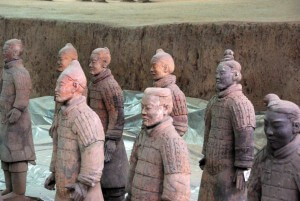 organization of the whole society. As the pictures show, terracotta soldiers were buried in order in rank in several long pits near the tomb of the first ruler - probably as guards and servants in the afterlife after death.
organization of the whole society. As the pictures show, terracotta soldiers were buried in order in rank in several long pits near the tomb of the first ruler - probably as guards and servants in the afterlife after death.
Swords, spears, halberds, and crossbows were most likely new and fully functional. The blades were ground with a rotating grinder. The analysis showed that the surface of 40000 arrowheads and crossbows is made of a bronze alloy containing about 20% tin and the remainder 3% tin, 1% lead and 96% copper. These heads were mounted on wooden parts and became deadly tools.
Some of the objects are very well preserved despite being exposed to moisture underground for up to 2200 years. This is due to the thin coating of chromium oxide. It is proof of the use of technologies that were exceptional at the time.
It is estimated that up to 700000 people participated in the creation of the ruler's mausoleum and necropolis (city of the dead) with an army of soldiers.
The bodies of terracotta soldiers were made of wet clay using molds and subsequently fired. The forms have been modified to create different figures with characteristic features. The heads, faces, ears, hair, and headgear of each member of the military are different, giving the impression that they are different people. The figures of soldiers and horses are divided according to the ranks of soldiers and arranged in a combat formation. For example, crossbow shooters were deployed in front of and behind horse-drawn carriages, where they could most effectively defend positions from the enemy.
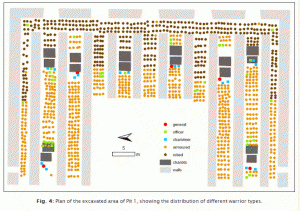
Legend: red - general, green - officer, blue - wagon, brown - soldier with armor, dark brown - pawn, dark gray - wagon, pale gray - walls
In four large and in many smaller pits with a total area of 22000 m² there are 8000 terracotta figures, 130 wagons with 520 horses and 150 riding horses.
Figures with a height of 1,7 - 2,0 m weigh 135 - 180 kg. Among them are actors, artists and civilian officials, as well as the armor of the Qin dynasty, which is located in smaller pits. The figures of the actors are half-naked in skirts. In the court of the monarch, they had the role of entertainers. Each of the terracotta actors is in a different pose.
The pits are 5-7 m deep and were built in the form of corridors or rooms. The corridors are paved with burnt bricks. The ceiling is made of wooden boards covered with a layer of cane mats. The pits were covered with soil to hide the army's existence.
The emperor is buried in the burial room, on which an 80 m high pyramid is built. The burial ground is located in a necropolis covering an area of 2,13 kmXNUMX. The outer walls of the complex are located on the east side, as if to protect the tomb from the conquered kingdoms. They are built of compacted soil as strong as concrete.
The four main pits with a depth of 7 m are 1,5 km to the east from the tomb.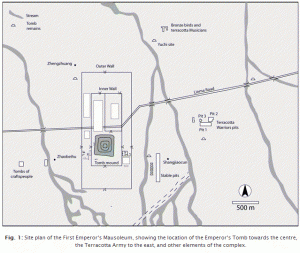
The No. 1 pit 230 m long with the main army first opened to the public in 1979 has 11 corridors, most of which are over 3 m wide. It is paved with small bricks. The ceiling was reinforced with beams and columns. Such a design was also used in the tombs of the nobility. The wooden ceilings were covered with reed mats with a layer of clay as insulation and covered with soil to a height of 2-3 m above the then soil level.
Pit No. 2, discovered in 1976 and opened to the public in 1994, houses cavalry, infantry and chariots and is intended as a military guard.
Pit No. 3 (discovered 1976 and made available in 1989) hides a command post with high-ranking officers and a chariot. The fourth pit remained empty and unfinished.
Over the course of 2000 years, the construction of the pits was subjected to soil pressure, collapsed and the figures damaged.
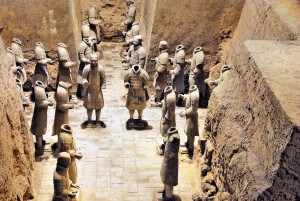 The first excavations lasted 6 years from 1978 to 1984. During this period, 1087 clay soldiers were discovered. The next phase began in 1985, but was interrupted after a year.
The first excavations lasted 6 years from 1978 to 1984. During this period, 1087 clay soldiers were discovered. The next phase began in 1985, but was interrupted after a year.
The Terracotta Army Museum in the Lintong area has been visited by about 1979 million visitors since 70, when it was opened to the public.
The Terracotta Army is one of the largest archaeological finds today and has been a UNESCO World Heritage Site since 1987.
In 2009, he began researching the original colors, which were applied to clay figures, using new technologies. The color pigments oxidized in air immediately after exposure.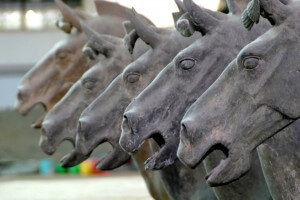
Archaeologists from the local museum have worked with experts from Germany to find suitable technology for detecting and preserving the original colors of terracotta soldiers. They hope that the colors at the next excavations will be preserved. Examination of the colors revealed that each figure had a characteristic color and the purple color was reserved for officers only.